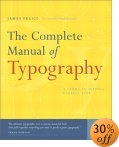encyclopedia of type and typography
This is a very elegantly-produced book which sets out the basic principles of type design and page layout. It bids to stand as a classic alongside the reigning Bible of typography – Robert Bringhurst’s The Elements of Typographic Style, which always comes top of typography favourites lists. It includes the basic concepts and anatomy of good typography: how type came about, how to set type, and the difference between type and fonts.
 Then comes how to manage fonts – techniques for working with leading, kerning, and managing indentation and alignment. There are sections which deal with setting type in language-specific instances such as using foreign character sets, which specialists will find useful. There’s even a chapter on dealing with style sheets – something which really does bridge the gap between print and digital culture. What’s interesting about this book is that it’s not just a historical survey. It covers all aspects of type design and applications of them in print and screen. It’s packed with illustrative examples, and anybody who has the slightest interest in typography will find something of interest in its detailed exposition of the basics. It’s an ambitious book, because it seeks to deal with type from Gutenburg to digital fonts. And it does it very well. There’s an extensive glossary and a very good index. Only the bibliography was rather disappointing.
Then comes how to manage fonts – techniques for working with leading, kerning, and managing indentation and alignment. There are sections which deal with setting type in language-specific instances such as using foreign character sets, which specialists will find useful. There’s even a chapter on dealing with style sheets – something which really does bridge the gap between print and digital culture. What’s interesting about this book is that it’s not just a historical survey. It covers all aspects of type design and applications of them in print and screen. It’s packed with illustrative examples, and anybody who has the slightest interest in typography will find something of interest in its detailed exposition of the basics. It’s an ambitious book, because it seeks to deal with type from Gutenburg to digital fonts. And it does it very well. There’s an extensive glossary and a very good index. Only the bibliography was rather disappointing.
For those who are still interested in using type for print rather than on screen, Felici covers all the niceties of font weight, ligatures, letter-spacing, hyphenation, and wrapping text around graphics. There are plenty of examples of well presented typesetting, with detailed analyses showing the subtle differences between them. This is like a mastercourse in the finer points of typography. He also covers issues such as footnotes, endnotes, picture captions, and bibliographies.
 There’s some amazing detail. I hadn’t appreciated before the difference between a standard and a punctuating m-dash. This stuff will appeal to typography buffs – and it’s all beautifully illustrated.
There’s some amazing detail. I hadn’t appreciated before the difference between a standard and a punctuating m-dash. This stuff will appeal to typography buffs – and it’s all beautifully illustrated.
I also enjoyed a section on document structure, in which he shows you how to arrange headings and various levels of sub-headings. This section could be useful for those people [like me] currently grappling with the possibilities of cascading style sheets.
For a book which covers the historical tradition as well as digital innovations, this is a remarkable achievement. As Frank Romano says in his introduction:
At this point, most people who work with type have to catch up with both what is old and what is new in typography. Fortunately, you have the solution in your hands: a concise, beautiful book that pulls together everything you need to produce great typography.
© Roy Johnson 2003
James Felici, The Complete Manual of Typography, Berkeley (CA): Peachpit Press, 2003, pp.360, ISBN 0321127307
More on typography
More on technology
More on digital media